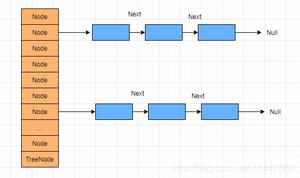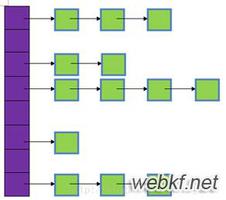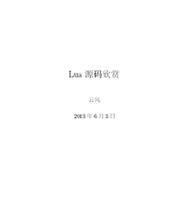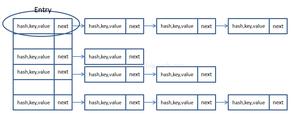HashMap在JDK8中的源码分析

补充:关于情况2和情况3:此时key1-value1和原来的数据以链表的方式存储。
在不断的添加过程中,会涉及到扩容问题,当超出临界值(且要存放的位置非空)时,扩容。默认的扩容方式:扩容为原来容量的2倍,并将原有的数据复制过来。
jdk8 相较于jdk7在底层实现方面的不同:
1. new HashMap():底层没有创建一个长度为16的数组
2. jdk 8底层的数组是:Node[],而非Entry[]
3. 首次调用put()方法时,底层创建长度为16的数组
4. jdk7底层结构只有:数组+链表。jdk8中底层结构:数组+链表+红黑树。
4.1 形成链表时,七上八下(jdk7:新的元素指向旧的元素。jdk8:旧的元素指向新的元素)
4.2 当数组的某一个索引位置上的元素以链表形式存在的数据个数 > 8 且当前数组的长度 > 64时,此时此索引位置上的所数据改为使用红黑树存储。
DEFAULT_INITIAL_CAPACITY : HashMap的默认容量,16
DEFAULT_LOAD_FACTOR:HashMap的默认加载因子:0.75
threshold:扩容的临界值,=容量*填充因子:16 * 0.75 => 12
TREEIFY_THRESHOLD:Bucket中链表长度大于该默认值,转化为红黑树:8
MIN_TREEIFY_CAPACITY:桶中的Node被树化时最小的hash表容量:64
源码:
put()方法:
public V put(K key, V value) {//调用key1所在类的hashCode()计算key1哈希值,此哈希值经过某种算法计算
return putVal(hash(key), key, value, false, true);
}
计算hash值:
static final int hash(Object key) {int h;
//key.hashCode()用了现有的hash
return (key == null) ? 0 : (h = key.hashCode()) ^ (h >>> 16);
}
putVal()方法:
final V putVal(int hash, K key, V value, boolean onlyIfAbsent, boolean evict) {Node<K,V>[] tab; Node<K,V> p; int n, i;
//首次添加元素
if ((tab = table) == null || (n = tab.length) == 0)
//初始化,造数组就是在resize()里做的
n = (tab = resize()).length;
//非首次添加元素,(n - 1) & hash得到在Entry数组中的存放位置,
if ((p = tab[i = (n - 1) & hash]) == null)
//如果此位置上的数据为空,此时的key1-value1添加成功。 ----情况1
tab[i] = newNode(hash, key, value, null);
else {
//如果此位置上的数据不为空,(意味着此位置上存在一个或多个数据(以链表形式存在))
Node<K,V> e; K k;
//比较key1和已经存在的一个或多个数据的哈希值
//如果key1的哈希值和已经存在的某一个数据(key2-value2)的哈希值相同,继续比较:比较key的地址或者调用key1所在类的equals(key2)方法,如果equals()返回true:把已存在的Node赋值给e,使用value1替换value2。
if (p.hash == hash &&
((k = p.key) == key || (key != null && key.equals(k))))
e = p;
else if (p instanceof TreeNode)
e = ((TreeNode<K,V>)p).putTreeVal(this, tab, hash, key, value);
else {
//如果key1的哈希值与已经存在的数据的哈希值都不相同,此时key1-value1添加成功。此时key1-value1和原来的数据以链表的方式存储----情况2
//如果key1的哈希值和已经存在的某一个数据(key2-value2)的哈希值相同,且调用key1所在类的equals(key2)方法,如果equals()返回false:此时key1-value1添加成功。此时key1-value1和原来的数据以链表的方式存储----情况3
for (int binCount = 0; ; ++binCount) {
if ((e = p.next) == null) {
p.next = newNode(hash, key, value, null);
//jdk8中底层结构:数组+链表+红黑树。当数组的某一个索引位置上的元素以链表形式存在的数据个数 > 8 且当前数组的长度 > 64时,此时此索引位置上的所数据改为使用红黑树存储。
//TREEIFY_THRESHOLD:Bucket中链表长度大于该默认值,转化为红黑树:8
if (binCount >= TREEIFY_THRESHOLD - 1) // -1 for 1st
treeifyBin(tab, hash);
break;
}
if (e.hash == hash &&
((k = e.key) == key || (key != null && key.equals(k))))
break;
p = e;
}
}
//使用value1替换value2
if (e != null) { // existing mapping for key
V oldValue = e.value;
if (!onlyIfAbsent || oldValue == null)
e.value = value;
afterNodeAccess(e);
return oldValue;
}
}
++modCount;
if (++size > threshold)
resize();
afterNodeInsertion(evict);
return null;
}
resize()方法:
final Node<K,V>[] resize() {Node<K,V>[] oldTab = table;
int oldCap = (oldTab == null) ? 0 : oldTab.length;
int oldThr = threshold;
int newCap, newThr = 0;
if (oldCap > 0) {
if (oldCap >= MAXIMUM_CAPACITY) {
threshold = Integer.MAX_VALUE;
return oldTab;
}
else if ((newCap = oldCap << 1) < MAXIMUM_CAPACITY &&
oldCap >= DEFAULT_INITIAL_CAPACITY)
newThr = oldThr << 1; // double threshold
}
else if (oldThr > 0) // initial capacity was placed in threshold
newCap = oldThr;
else { // zero initial threshold signifies using defaults
//首次添加元素,DEFAULT_INITIAL_CAPACITY : HashMap的默认容量,16;DEFAULT_LOAD_FACTOR:HashMap的默认加载因子:0.75
newCap = DEFAULT_INITIAL_CAPACITY;
newThr = (int)(DEFAULT_LOAD_FACTOR * DEFAULT_INITIAL_CAPACITY);//12
}
if (newThr == 0) {
float ft = (float)newCap * loadFactor;
newThr = (newCap < MAXIMUM_CAPACITY && ft < (float)MAXIMUM_CAPACITY ?
(int)ft : Integer.MAX_VALUE);
}
//threshold:扩容的临界值,=容量*填充因子:16 * 0.75 => 12
threshold = newThr;
@SuppressWarnings({"rawtypes","unchecked"})
Node<K,V>[] newTab = (Node<K,V>[])new Node[newCap]; //创建数组
table = newTab;
if (oldTab != null) {
for (int j = 0; j < oldCap; ++j) {
Node<K,V> e;
if ((e = oldTab[j]) != null) {
oldTab[j] = null;
if (e.next == null)
newTab[e.hash & (newCap - 1)] = e;
else if (e instanceof TreeNode)
((TreeNode<K,V>)e).split(this, newTab, j, oldCap);
else { // preserve order
Node<K,V> loHead = null, loTail = null;
Node<K,V> hiHead = null, hiTail = null;
Node<K,V> next;
do {
next = e.next;
if ((e.hash & oldCap) == 0) {
if (loTail == null)
loHead = e;
else
loTail.next = e;
loTail = e;
}
else {
if (hiTail == null)
hiHead = e;
else
hiTail.next = e;
hiTail = e;
}
} while ((e = next) != null);
if (loTail != null) {
loTail.next = null;
newTab[j] = loHead;
}
if (hiTail != null) {
hiTail.next = null;
newTab[j + oldCap] = hiHead;
}
}
}
}
}
return newTab;
}
treeifyBin(tab, hash)方法:
final void treeifyBin(Node<K,V>[] tab, int hash) {int n, index; Node<K,V> e;
if (tab == null || (n = tab.length) < MIN_TREEIFY_CAPACITY)
//如果数组长度<64,则扩容
resize();
else if ((e = tab[index = (n - 1) & hash]) != null) {
TreeNode<K,V> hd = null, tl = null;
do {
TreeNode<K,V> p = replacementTreeNode(e, null);
if (tl == null)
hd = p;
else {
p.prev = tl;
tl.next = p;
}
tl = p;
} while ((e = e.next) != null);
if ((tab[index] = hd) != null)
hd.treeify(tab);
}
}
以上是 HashMap在JDK8中的源码分析 的全部内容, 来源链接: utcz.com/z/518986.html









